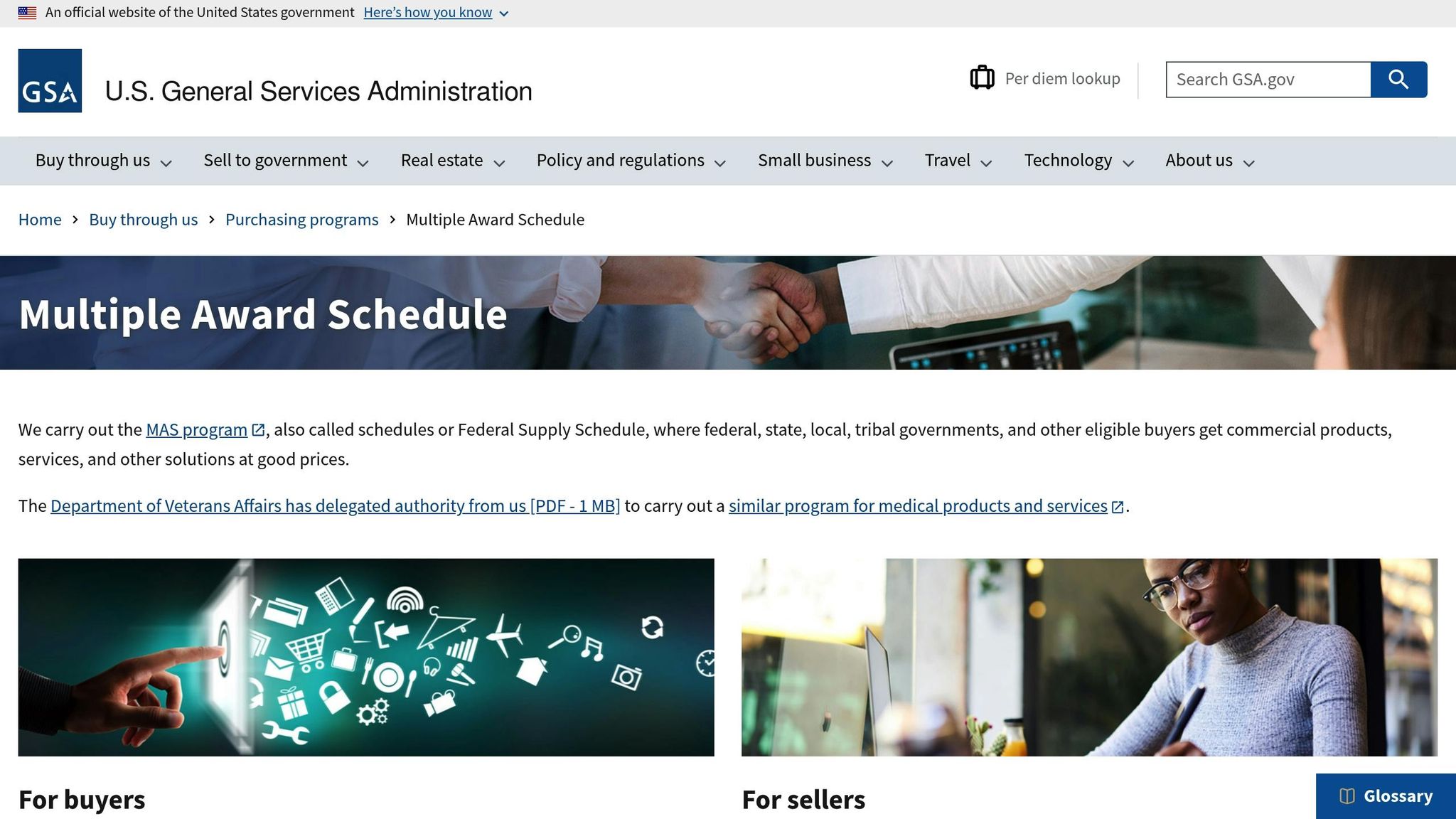A Contractor Team Arrangement (CTA) is a partnership between two or more companies, each holding a GSA Schedule contract, to work together on federal projects. Unlike subcontracting, where one company oversees others, CTAs allow all members to collaborate equally while maintaining their independence. Each contractor has a direct legal relationship with the government, ensuring transparency in pricing and accountability for their specific contributions.
Key Features of CTAs:
- Direct Contracts: Each team member invoices the government directly using their GSA Schedule.
- Collaborative Approach: No hierarchy – team members share responsibilities and coordinate efforts.
- Lead Contractor: One company acts as the main point of contact with the government.
- Defined Roles: Each contractor focuses on their area of expertise outlined in their GSA Schedule.
- Legal Agreements: Clear documentation outlines roles, pricing, and communication protocols.
Benefits:
- For Small Businesses: Opportunity to bid on larger federal contracts by teaming up with complementary partners.
- For Government Agencies: Simplifies procurement by offering integrated solutions under one arrangement.
CTAs offer a streamlined way for businesses to access federal opportunities while ensuring efficient project management and compliance with GSA regulations.
How CTAs Work and Their Key Features
CTA Structure and Organization
CTAs (Contractor Team Arrangements) operate differently from traditional subcontracting models. Instead of a hierarchical structure, they use a collaborative approach where each contractor maintains independence while working together to meet project goals. Unlike the prime-subcontractor setup, every team member has a direct contractual relationship with the government agency.
Here’s how it works: Each contractor focuses on their specific area of expertise as outlined in their GSA Schedule. For example, a cybersecurity contractor handles security deliverables, an IT services provider manages infrastructure, and a training company oversees workforce development. This setup streamlines operations, as each contractor directly invoices the government, cutting out the delays often caused by subcontracting chains.
The lead contractor plays a crucial role as the team’s communication hub with the government. However, they don’t control the operations of other team members. Instead, they coordinate project timelines, facilitate information sharing, and ensure that all deliverables align seamlessly with the project’s overall objectives. Importantly, each contractor retains their existing GSA Schedule pricing and terms, ensuring the competitive rates they’ve already negotiated remain intact.
One of the standout features of CTAs is that team members maintain privity of contract with the government. This means each contractor has a direct legal relationship with the agency, providing transparency and accountability. Government agencies benefit from this setup, as they can clearly see what they’re paying each contractor and hold them directly responsible for their specific deliverables.
To ensure smooth collaboration, CTAs rely on regular team meetings, shared project management tools, and clearly defined interfaces between the different work streams. Each contractor must ensure their deliverables integrate seamlessly with the others while adhering to their GSA Schedule compliance requirements. These operational details are essential for understanding how CTAs function and the steps required to form one.
Requirements for Forming a CTA
To form a CTA, all team members must hold active GSA Schedules that cover their respective services. This ensures that their pricing, terms, and conditions have already been reviewed and approved by GSA.
A key step in forming a CTA is drafting a detailed agreement that outlines roles, responsibilities, and work distribution. This agreement must specify which contractor will handle each part of the project, define communication protocols, and establish how the team will coordinate its efforts. Such documentation is critical when responding to government solicitations, as agencies need a clear understanding of how the team will operate.
Pricing coordination is another essential aspect. While each contractor uses their individual GSA Schedule pricing, the team must present a unified pricing structure to the government. This involves resolving any overlapping capabilities, ensuring competitive pricing, and clearly defining each contractor’s scope to avoid conflicts.
The team must also designate a lead contractor to act as the primary point of contact with the government. This contractor is responsible for proposal submissions, contract negotiations, and ongoing communication. However, the lead contractor does not have authority over the internal operations of the other team members.
Legal agreements between team members form the foundation of the collaboration. These agreements address critical areas such as intellectual property rights, liability allocation, and dispute resolution. They must align with GSA regulations while protecting each contractor’s interests and preserving their ability to compete independently on other projects.
Finally, the team must demonstrate complementary skills that deliver a cohesive solution. GSA expects CTAs to provide integrated capabilities that individual contractors cannot offer alone. The team composition should highlight synergies and enhanced value delivery, ensuring that the government receives a solution that’s greater than the sum of its parts.
Contractor Team Arrangements and the GSA MAS Program

Benefits of Contractor Team Arrangements
Contractor Team Arrangements (CTAs) open the door to larger federal contracts while making the procurement process smoother for both small businesses and government agencies. By combining the unique strengths of participants through GSA Schedules, CTAs allow businesses to bid on projects that might be too challenging to tackle alone.
Benefits for Small Businesses
For small businesses, CTAs are a game-changer. These arrangements let companies with complementary expertise join forces, enabling them to compete for broader, more complex contracts. Instead of being limited to a single area of focus, businesses can collaborate to deliver comprehensive solutions. Each partner maintains its own pricing structure and handles direct invoicing, ensuring transparency and simplicity.
CTAs also open doors to new markets. By teaming up, businesses can expand their service offerings and access contracting opportunities that might otherwise be out of reach. This collaborative approach not only strengthens individual businesses but also increases their competitive edge in the federal marketplace.
Advantages for Government Agencies
Government agencies also reap considerable benefits from CTAs. They simplify the procurement process by consolidating multiple contract components into one streamlined acquisition. This means fewer headaches for agencies, as communication and coordination become much more straightforward.
The lead contractor in a CTA serves as the main point of contact, making it easier for agencies to manage the project. While each team member maintains a direct contractual relationship with the agency, having a single liaison improves accountability and ensures smoother communication. This setup allows government buyers to monitor progress and address issues efficiently.
Another major advantage is the ability to deliver tailored solutions. CTAs leverage the unique strengths of each team member to provide comprehensive services, all while maintaining transparent pricing based on GSA Schedule rates. Plus, as project requirements evolve, CTA teams can adapt their offerings to meet changing needs.
"For the government buyer, the benefit is simple: buyers are able to solicit and obtain the total solution that they’re looking for, with all aspects of their requirements included."
"Contractor team arrangements may be desirable from both a Government and industry standpoint in order to enable the companies involved to:
Complement each other’s unique capabilities; and
Offer the Government the best combination of performance, cost, and delivery for the system or product being acquired."
The combined strengths of CTAs make them a powerful tool for delivering comprehensive and efficient federal contracting solutions.
CTAs vs. Prime/Subcontractor Arrangements
Understanding the differences between Contractor Team Arrangements (CTAs) and prime/subcontractor relationships is crucial. These two approaches vary in structure, responsibility, and payment processes, which can significantly impact transparency and efficiency in federal contracting.
Key Differences Between CTAs and Subcontracting
In a prime/subcontractor setup, the prime contractor is the sole party holding a direct contract with the government. This contractor manages all agreements with subcontractors, acting as the central point for communication and payment. In contrast, CTAs allow each team member to work directly with the government, including invoicing under their own GSA Schedule contracts. This eliminates delays and avoids the complexities of payment passing through a middleman.
Payment processes highlight another notable difference. In prime/subcontractor arrangements, the government pays the prime contractor, who then distributes payments to subcontractors based on their private agreements. This setup can create cash flow challenges, especially for smaller subcontractors waiting on the prime to process payments. With CTAs, each team member directly invoices the government for their portion of the work, ensuring quicker payments and better financial clarity.
Another distinction lies in the GSA Schedule requirement. In CTAs, every participant must hold their own GSA Schedule contract, ensuring they meet the government’s standards for pricing and terms. In a prime/subcontractor arrangement, only the prime contractor needs a GSA Schedule, so subcontractors can participate without direct government contracts.
| Aspect | Contractor Team Arrangement | Prime/Subcontractor |
|---|---|---|
| Contract Relationship | All members have direct contracts with the government | Only the prime contractor holds a government contract |
| GSA Schedule Requirement | Each member must hold their own GSA Schedule | Only the prime contractor needs a GSA Schedule |
| Payment Process | Members invoice the government directly | Government pays the prime, who then pays subcontractors |
| Communication Structure | Lead contractor coordinates, but all team members can communicate directly with the government | All communication flows through the prime contractor |
| Liability and Responsibility | Each member is responsible for their own work | Prime contractor is liable for all work, including subcontractor performance |
| Pricing Transparency | Based on published GSA Schedule rates | Subcontractor pricing is privately negotiated with the prime contractor |
The allocation of risk is another critical distinction. In a prime/subcontractor arrangement, the prime contractor assumes full responsibility for the project and the performance of subcontractors. If a subcontractor fails to deliver, the prime contractor remains accountable to the government. In CTAs, each member is only liable for their specific portion of the work, which balances the overall risk across the team.
Government agencies also benefit from greater flexibility with CTAs. In a prime/subcontractor model, agencies often have limited insight into subcontractor capabilities and pricing, relying entirely on the prime for oversight. CTAs, however, provide agencies with direct access to each team member’s expertise and transparent pricing. This structure allows for more informed decision-making and better project oversight.
These differences make CTAs an appealing choice for complex projects that require diverse expertise. Instead of relying on one company to subcontract specialized tasks, CTAs enable agencies to work directly with subject matter experts while enjoying the convenience of coordinated management. This approach ensures both efficiency and expertise in tackling intricate federal projects.
sbb-itb-8737801
How to Form and Manage a CTA
Creating a successful Contractor Team Arrangement (CTA) involves thoughtful planning, clear documentation, and consistent oversight. For small businesses, following a structured approach can simplify the process and set the stage for effective collaboration.
Steps to Form a CTA
Start by identifying the right partners – businesses that complement your strengths rather than compete with them. Each partner must already hold their own GSA Multiple Award Schedule (MAS) Contract. Look for companies whose services or products fill gaps in your offerings, enabling you to present a comprehensive solution to government agencies.
Once you’ve found the right partners, draft a CTA agreement. This document should clearly define the roles and responsibilities of each team member. Include essential details such as the names, addresses, GSA MAS Contract numbers, and points of contact for all participating contractors. Designate one company as the Team Leader and outline their specific duties, including how leadership transitions will be handled if needed. Also, clarify the responsibilities and limitations of each team member within the arrangement.
The agreement should establish the duration of the partnership and outline terms for possible extensions, so everyone understands their level of commitment. Break down the specific tasks involved in the CTA, identifying which team member is responsible for each, particularly when it comes to delivery and performance. Additionally, lay out procedures for communication and invoicing to ensure smooth coordination with government agencies and direct invoicing processes.
Once the CTA is in place, focus on maintaining its effectiveness through strong management practices.
Best Practices for Managing a CTA
Good management starts with thorough documentation. Keep detailed records of communications, project deliverables, and compliance activities. These records can be invaluable during audits or when resolving disputes.
Regular communication is key to keeping the team aligned. Schedule recurring meetings to review progress, address challenges, and discuss upcoming deliverables. Establish a clear process for escalating issues that require immediate attention.
Each contractor must comply with their individual GSA Schedule obligations as well as any CTA-specific requirements. A shared compliance calendar can help track deadlines, renewal dates, and reporting responsibilities, ensuring nothing falls through the cracks.
Set measurable performance goals and review them regularly. This not only helps identify areas for improvement but also demonstrates the team’s value to government clients.
Finally, maintain coordinated communication with government agencies. While team members can interact directly with agency representatives, key updates and discussions should be shared with the Team Leader. This ensures transparency and avoids sending mixed messages.
How GSA Focus Can Help

GSA Focus simplifies the process of forming and managing CTAs, helping businesses maximize their potential in federal contracting. With deep expertise in GSA Schedule contracts, they assist with every step of CTA formation – from drafting agreements to ensuring regulatory compliance.
Their done-for-you model takes care of the technical details, allowing business owners to focus on finding the right partners and building a strong strategy. GSA Focus handles the paperwork and compliance management so you can concentrate on collaboration.
Beyond formation, GSA Focus offers ongoing support to keep your CTA running smoothly. They provide services like compliance monitoring, documentation management, and team coordination guidance. With a 98% success rate, they’ve proven their ability to navigate the complexities of federal contracting.
For businesses unfamiliar with CTAs, GSA Focus offers advisory services to help avoid common mistakes and implement effective strategies from the start. This support empowers small businesses to pursue larger federal opportunities with confidence and clarity.
Conclusion
CTAs give small businesses a chance to compete for larger federal contracts by fostering direct, collaborative relationships with the government. The key to success lies in choosing partners whose strengths complement one another and establishing well-defined roles, responsibilities, and communication strategies. This thoughtful planning not only ensures project success but also sets the stage for future opportunities in the federal market.
By combining resources and expertise, CTAs allow businesses to pursue contracts that might otherwise be out of reach. They create a pathway for companies to tackle projects that exceed their individual capabilities.
To make the most of these opportunities, having expert guidance is invaluable. GSA Focus takes the complexity out of forming CTAs by handling everything from document preparation to compliance and negotiations. Their streamlined process allows business owners to concentrate on building meaningful, strategic partnerships.
CTAs are a smart way to achieve steady growth and tap into federal contracting opportunities. Their structured approach, emphasizing clear communication and shared responsibilities, reflects the many benefits discussed earlier.
FAQs
What is the difference between a Contractor Team Arrangement (CTA) and a traditional subcontracting model?
A Contractor Team Arrangement (CTA) stands apart from a traditional subcontracting model in how tasks and responsibilities are structured. In a CTA, every team member operates as an independent contractor, maintaining a direct relationship with the government. This setup encourages collaboration, as team members can pool their expertise and resources to meet the contract’s demands more effectively.
On the other hand, a traditional subcontracting model places all responsibility on the prime contractor. The prime contractor acts as the sole point of contact with the government, managing subcontractors who report directly to them. In this model, the prime contractor bears full accountability for the contract’s outcomes. While CTAs promote a more collaborative and balanced working relationship, traditional subcontracting centralizes control and oversight under the prime contractor.
What are the key steps to creating a successful Contractor Team Arrangement (CTA)?
To build a strong Contractor Team Arrangement (CTA), begin by selecting partners whose expertise and resources effectively complement yours. Clearly outline the roles and responsibilities of each team member, and make sure these details are documented in a formal agreement signed by all parties. This agreement should also include key elements like payment terms, procedures for resolving disputes, and adherence to government regulations.
The foundation of a successful CTA lies in early planning, open communication, and a strong sense of mutual trust. These elements help align your team’s objectives and improve your chances of success in government contracting. When your team operates cohesively, you’ll be better equipped to meet federal requirements and tap into new business opportunities.
What are the benefits of Contractor Team Arrangements (CTAs) for small businesses pursuing federal contracts?
Contractor Team Arrangements (CTAs): A Boost for Small Businesses
Contractor Team Arrangements (CTAs) offer small businesses a smart way to pool resources and compete for federal contracts. By joining forces with other contractors, small businesses can share expertise, expand capabilities, and deliver more well-rounded solutions that align with government needs.
These partnerships can also help businesses access contracts they might struggle to secure alone, creating new opportunities in the federal marketplace. On top of that, CTAs provide the flexibility to adjust to shifting government demands, making it easier for small businesses to stay relevant and expand their presence in the world of government contracting.
Related posts
- Types of GSA Teaming Agreements Explained
- Roles in GSA Teaming Agreements Explained
- Ultimate Guide to Teaming Agreements for Small Businesses
- Best Practices for Small Business Teaming Success


